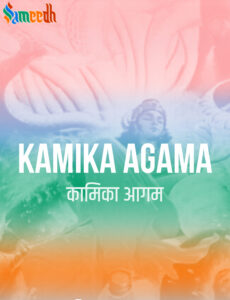The Kamika Agama is one of the ancient scriptures of Hinduism, specifically belonging to the Agama category, which deals with rituals, temple construction, and various aspects of worship. The word “Kamika” means “Desired” or “Wished for,” and it is believed to have been revealed by Lord Shiv himself to his consort, Devi Parvati.

The foremost scripture that came out of the Sadyojata face of Sadashiva, and was directly uttered by Lord Shiv to Devi and a Sadhaka / Sapta Rishi (sage) called Pranav on Mount Meru in Ujjain, India. Pranav transmitted it to another sage called Trikala who in turn revealed it to a third sage called Hara.
The Kamika Agama, like other Agamas, covers a wide range of subjects related to temple construction, deity worship, rituals, yoga practices, and philosophical teachings. It provides detailed instructions on how to build and consecrate temples, including the dimensions, architectural features, and the placement of deities. It also outlines various rituals and ceremonies to be performed in temples for different occasions.
In addition to its emphasis on temple rituals, the Kamika Agama also discusses spiritual practices such as meditation, mantra recitation, and yoga. It offers insights into the nature of reality, the relationship between the individual soul (jiva) and the universal consciousness (Shiv), and the path to liberation (moksh).
The Kamika Agama, along with other Agamas, plays a significant role in shaping the religious and spiritual practices of the Shaiva Agama tradition within Hinduism. It is studied and followed by priests, scholars, and devotees interested in the worship of Lord Shiv and the construction and maintenance of temples dedicated to him.
The Kamika Agama teaches not only an enlightened art of living, but also the art of enlightened living and is a supreme scripture that is associated with four sections – Charya (lifestyle), Kriya (spiritual process), Yoga (union or methods of uniting with the divine) and Jnana (enlightenment).
The Kamika Agama holds a significant role within Hinduism, particularly in the Shaiva tradition. Here are some key roles and aspects of its significance:
- Temple Construction: The Kamika Agama provides detailed guidelines and principles for the construction of temples dedicated to Lord Shiv. It outlines specifications for the architecture, layout, design, and consecration rituals of Shiv temples. These guidelines ensure that the temples are built in accordance with sacred principles, facilitating a conducive environment for worship and spiritual practices.
- Deity Worship: This scripture elucidates the rituals and ceremonies associated with the worship of Lord Shiv and other deities within the Shaiva tradition. It prescribes various offerings, prayers, and rituals to be performed by priests and devotees to honor the divine. By following the instructions of the Kamika Agama, worshippers can engage in the worship of Shiv in a manner believed to be pleasing to the deity.
- Spiritual Practices: In addition to temple rituals, the Kamika Agama expounds upon spiritual practices such as meditation, mantra recitation, and yoga. It offers guidance on how devotees can deepen their connection with Shiv and progress on the path of spiritual evolution. Through these practices, individuals seek to attain spiritual enlightenment and liberation (moksh).
- Philosophical Insights: The Kamika Agama contains philosophical teachings concerning the nature of reality, the relationship between the individual soul (jiva) and the universal consciousness (Shiv), and the ultimate goal of life. It delves into metaphysical concepts, elucidating the nature of the divine, the cosmos, and the individual’s place within it. These teachings serve to inspire contemplation and deepen one’s understanding of the Shaiva worldview.
- Cultural Preservation: As an ancient scripture, the Kamika Agama contributes to the preservation and propagation of Shaiva culture and tradition. It serves as a repository of sacred knowledge passed down through generations, guiding the faithful in their religious practices and preserving the architectural and ritualistic heritage associated with Shiv worship.
Overall, the Kamika Agama plays a multifaceted role in shaping the religious, spiritual, and cultural landscape of Hinduism, particularly within the Shaiva tradition. It serves as a guidebook for temple construction, deity worship, spiritual practices, and philosophical contemplation, offering devotees a framework for leading a life imbued with devotion and spiritual fulfillment.